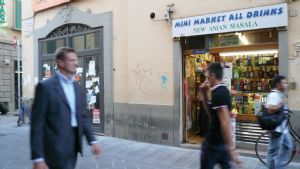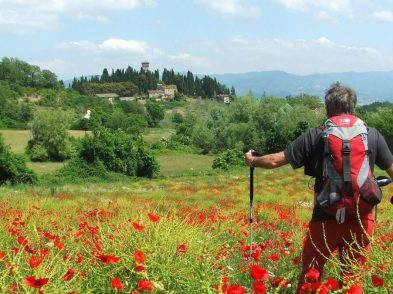Few people would argue that Villa Gamberaia is the jewel in Settignano’s crown, though it didn’t always shine as brilliantly as it has in the last hundred years or so. Built around 1610 by Zanobi Lapi, it passed through many hands before being purchased in 1896 by the Rumanian Princess Ghyka. Villa Gamberaia was reportedly in a sad state by then, but under Princess Ghyka’s loving care it again became a place of enchantment and beauty, to which a privileged few had access. In 1925 she sold the property to the American-born Baroness von Ketteler, who in 1952 donated it to the Holy See. Two years later Marcello Marchi acquired it and restored the house, which had been badly damaged during World War II. The Gamberaia now belongs to Signor Marchi’s son-in-law Luigi Zalum (see the anthology Revisiting the Gamberaia, ed. P.J. Osmond, Florence 2004).
Mr. and Mrs. Berenson of Villa I Tatti were among the privileged few who had the entrée to Villa Gamberaia at the time of Princess Ghyka’s ownership. When she invited them to tea, they’d walk up the hill to Settignano and along country lanes for several kilometres. That was in the early 1900s. Things are easier today. The Gamberaia gardens are open to all, and a ride on bus 10 to the end of the line, followed by a walk of about a kilometre to Via Rossellino 72, will bring you there. If you have a car, drive the same route.
As you begin to explore the Gamberaia, you’ll become aware that it’s laid out on an irregular site, formed like a terrace jutting from the hillside. Although relatively small, the grounds include most of the features found in larger Italian gardens: a formal area with parterres, fountains, a
secret garden, a citrus garden, boschetti, a grassy area, and a nymphaeum. These features are disposed along two main longitudinal and several cross axes.
You enter along the first longitudinal axis, a cypress-lined avenue leading directly to the villa, though it does not, as you would expect, lead to the main entrance into the house. This is just one of the Gamberaia’s many intriguing puzzles. If you walk around the villa to the right, you’ll see a large arched opening in the façade, aligned with a breathtaking view over Florence. But this isn’t the main entrance either. The longitudinal axis continues behind the villa with a formal garden, comprising water pools stretching to an arcaded hemicycle of cypresses. This area was boldly transformed by Princess Ghyka, who replaced the earlier planted parterres with water parterres, surrounding them with colourful flowers. Baroness von Ketteler substituted the flowers with evergreen topiary bushes, giving the garden the monochromatic character that it has retained to this day. The best view of the formal garden is from the upper loggia in the house.
Wandering eastwards, you arrive at a grassy avenue running the length of the grounds, which is the second longitudinal axis of the design. It’s marked at the south end by a balustraded terrace and at the north by a nymphaeum. Resist the pull of the distant nymphaeum for the moment because you won’t want to miss the hilly boschetto, reached via an opening in the retaining wall on your right. The boschetto is one of several areas laid out on the shorter cross axes of the garden. Further down the grassy avenue you’ll come to another cross axis, with a gate on your right that leads into the so called gabinetto rustico, a charming interpretation of the typical, walled secret garden, and on your left a large door leading into the villa. No one has yet been able to explain why the largest entranceway into the villa is aligned not with the principal access road but with the smaller and more private route between the house and the secret garden. The gabinetto rustico has walls encrusted with pumice and shells. Statues and busts of the Seasons decorating the tops of the walls are a reminder of the importance of the cycles of the year to country life.
Stairs along the two long sides of the gabinetto rustico bring you to the upper-level lemon garden, filled with neatly arranged potted plants. Along the northern perimeter is the spacious limonaia. A passage to the left of the limonaia gives access to another boschetto, with a trail leading back down to the northern end of the grassy avenue. Here, in the grassy avenue, you find yourself face-to-face with the nymphaeum. Walls decorated with pumice, shells and bas-reliefs of musicians and rustics flank the monumental niche, which is dominated by a satanic looking figure, sometimes identified as Neptune.
Now, you may not have been able to sip tea with Princess Ghyka on the lawn of the Gamberaia, but you can wrap up your excursion with a treat that Mr. and Mrs. Berenson
would not even have dreamt about as they returned home. Stop off at the Enoteca La Sosta del Rossellino, Via Rossellino 2r, for aperitifs or dinner, or both. The wines are divine, the food superb, the atmosphere enchanting.
The Gamberaia is open daily, including holidays, from 9am to 6pm. Entrance costs ��10. (055-697205).
La Sosta del Rosselino is open daily except Sundays, 6-9 pm for aperitifs, 7.30 pm-1am for dinner.
(055-697245)







